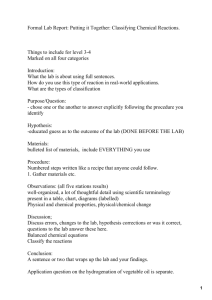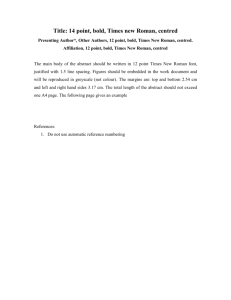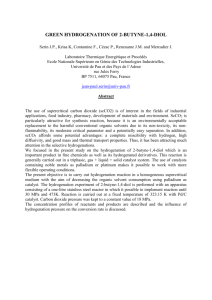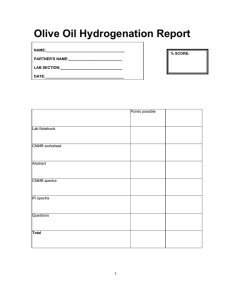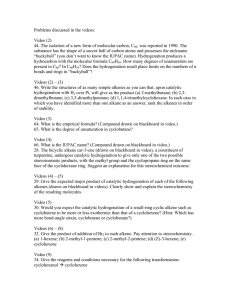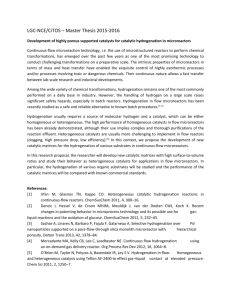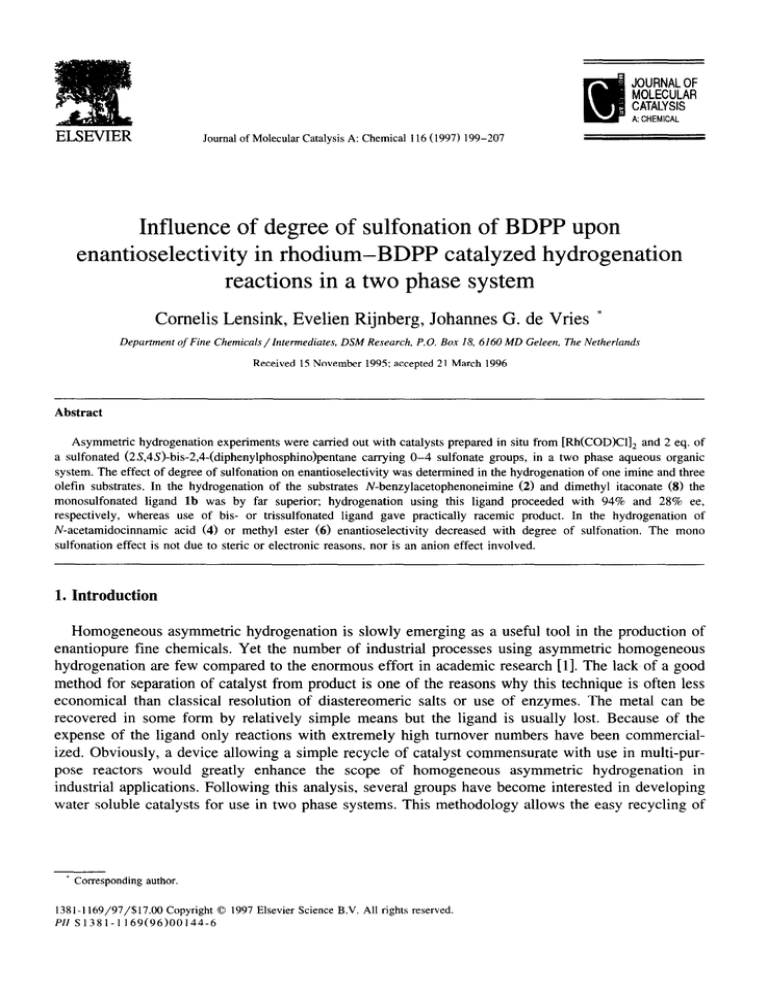
JOURNAL OF
MOLECULAR
CATALYSIS
A: CHEMICAL
ELSEVIER
Journal of Molecular Catalysis A: Chemical 116 (1997) 199-207
Influence of degree of sulfonation of BDPP upon
enantioselectivity in rhodium-BDPP catalyzed hydrogenation
reactions in a two phase system
Cornelis Lensink, Evelien Rijnberg, Johannes G. de Vries
Department
of Fine Chemicals/Intermediates,
*
DSM Research, P.O. Box 18, 6160 MD Geleen, The Netherlands
Received 15 November 1995: accepted 21 March 1996
Abstract
Asymmetric hydrogenation experiments were carried out with catalysts prepared in situ from [Rh(COD)CI], and 2 eq. of
a sulfonated (2S,4S)-bis-2,4-(diphenylphosphino)pentane
carrying O-4 sulfonate groups, in a two phase aqueous organic
system. The effect of degree of sulfonation on enantioselectivity
was determined in the hydrogenation of one imine and three
olefin substrates. In the hydrogenation
of the substrates N-benzylacetophenoneimine
(2) and dimethyl itaconate (8) the
monosulfonated
ligand lb was by far superior; hydrogenation
using this ligand proceeded with 94% and 28% ee,
respectively,
whereas use of bis- or trissulfonated
ligand gave practically racemic product. In the hydrogenation
of
N-acetamidocinnamic
acid (4) or methyl ester (6) enantioselectivity
decreased with degree of sulfonation. The mono
sulfonation effect is not due to steric or electronic reasons, nor is an anion effect involved.
1. Introduction
Homogeneous asymmetric hydrogenation is slowly emerging as a useful tool in the production of
enantiopure fine chemicals. Yet the number of industrial processes using asymmetric homogeneous
hydrogenation are few compared to the enormous effort in academic research [l]. The lack of a good
method for separation of catalyst from product is one of the reasons why this technique is often less
economical than classical resolution of diastereomeric
salts or use of enzymes. The metal can be
recovered in some form by relatively simple means but the ligand is usually lost. Because of the
expense of the ligand only reactions with extremely high turnover numbers have been commercialized. Obviously, a device allowing a simple recycle of catalyst commensurate with use in multi-purpose reactors would greatly enhance the scope of homogeneous
asymmetric hydrogenation
in
industrial applications. Following this analysis, several groups have become interested in developing
water soluble catalysts for use in two phase systems. This methodology allows the easy recycling of
* Corresponding author.
1381-l 169/97/$17.00 Copyright 0 1997 Elsevier Science B.V. All rights reserved.
169(96)00144-6
PII S1381-I
200
C. Lensink et al/Journal
of Molecular Catalysis A: Chemical 116 (1997) 199-207
[Rh(COD)CI]z I 1
Solvent, Hz 70 bar
2
3
Scheme 1. Asymmetric
hydrogenation
of 2 using [Rh(COD)Cl],
/l as catalyst.
the catalyst by reuse of the aqueous phase after separating the product which remains exclusively in
the organic phase [2-41.
We became interested in water soluble catalysts when working in the area of asymmetric imine
hydrogenation. The rhodium-diphosphine catalyzed hydrogenation of a selected number of imines
proceeds with medium to high enantioselectivity, but in all reported instances the reaction is slow,
with turnover frequencies in the order of l-10 h- ’ [5]. Amrani et al. did pioneering work in this area
by establishing
that use of the tetrasulfonated
diphosphine
ligand (2S,4S)-2,4bis(diphenylphosphino)pentane (BDPP) (le) in the rhodium catalyzed hydrogenation of imines in an
aqueous/organic two phase system gave rise to only slightly reduced enantioselectivities when
compared to the parent diphosphine la and allows for easy recycling of the catalyst [6]. However, the
enantioselectivity of this reaction is still not high enough for practical use.
An interesting new development emerged when Bakos et al. found that the use of BDPP ligand that
was only partially sulfonated (i.e., less than 4 sulfonate groups) gave rise to very high enantioselectivities in the two phase rhodium catalyzed hydrogenation of N-benzylacetophenoneimine (2) (Scheme
1) [7]. This extraordinary effect is hard to explain in view of the fact that an incompletely sulfonated
bisphosphine consists of a mixture of phosphines which differ in degree of sulfonation. In addition,
the sulfonation of only one of the aryl groups attached to a single phosphorus atom as in lc and Id
creates chirality at phosphorus resulting in the formation of epimers (Scheme 2).
Working on the assumption that one of the ligands in this mixture forms a complex with rhodium
that is highly enantioselective and kinetically superior, we proceeded to isolate the monosulfonated
and the disulfonated ligand [8]. This was accomplished by chromatography over silica. Diastereomers
due to chirality on phosphorus where inseparable, even on analytical HPLC. However, oxidation of
the phosphines with H,O, gave the bisphosphine oxides, that could be separated on analytical HPLC
(Fig. 1).
From this, it became clear that sulfonation proceeds with zero induction. A statistical distribution of
the diastereomers was found: a 1:1 mixture of the mono-sulfonated ligand and a 1:2: 1 mixture of the
bissulfonated ligand.
Catalysts were prepared in situ from [Rh(COD)Cl], and 2 equivalents of ligand. Hydrogenation of
N-benzylacetophenoneimine was performed with these in situ prepared catalysts at a pressure of 70
lb
&A
2
4
Time (min.)
Fig. 1. HPLC trace of sulfonation
2
4
6
Time (min.)
reaction of la (7.5 min) before and after treatment with H,O,
(right).
C. Lensink et al. /Journal
201
of Molecular Catalysis A: Chemical I16 (1997) 199-207
Th
k’h
Ph’&P
;
la
lb’
?
I
9’
I er
,r
Ph
+h
*+f
4’
‘Ph
br
%‘h
E
I
I
3’
f’
Ar/PwLPh
i:
I
1d”
Id’
3’
1
g I
c’
ArHPeP’Ar
Ar =
le
Scheme 2. Products of the sulfonation
of la.
bar H, in a two phase system (EtOAc/H,O).
These experiments revealed that the rhodium-complex
with monosulfonated ligand gave the amine product in 94% ee, whereas with the bissulfonated ligand
a practically racemic product was obtained [8].
From the coloration of the two phases it became clear that the catalyst formed from lb dissolves in
the organic phase only, which can be explained by the formation of an internal ion pair (Fig. 2). The
complex with lc dissolves exclusively in the aqueous phase.
In view of the fact that the monosulfonated ligand is a 1: 1 mixture of diastereomers, it is hard to
find an explanation for the high enantioselectivity
based upon steric grounds. A number of other
hypotheses can be advanced that can be verified by experimental means. One hypothesis is based on
I
soaOrganic soluble
~O&~’
60,
Water soluble
Fig. 2. Relation between solubility of rhodium complexes
and degree of sulfonation.
202
C. Lensink et al. /Journal
of Molecular Catalysis A: Chemical 116 (1997) 199-207
the assumption that difference in electron density at the two phosphorus atoms is the key factor. If this
is the case, one would expect to find a reasonably high enantioselectivity
in these hydrogenation
reactions if the trissulfonated ligand is used. For this reason we decided to synthesize and isolate
trissulfonated BDPP (Id). Preparation of the ligands with all other possible degrees of sulfonation had
been described before [6,8].
It is also possible that the peculiar monosulfonation effect is due to some interaction that is related
to the imine substrate. Exploration of the hydrogenation
of other prochiral substrates could shed
additional light on this matter.
Another verifiable hypothesis rests on the assumption that the high enantioselectivity
is a
consequence of the formation of a cationic complex which has an internal sulfonate as anion. Using
other cationic rhodium(BDPP) complexes as catalyst should therefore lead to higher enantioselectivity
than the analogous chloride.
This paper describes the results of these experiments aimed at understanding the origin of the high
enantioselectivity
with the monosulfonated rhodium complex in the imine hydrogenation.
2. Experimental
2.1. Materials and methods
GC analyses were performed on a HP 5890 Series II gas chromatography
apparatus using a
capillary Chrompack CP Sil 5CB column (25 m X 0.32 mm). For analyses of amines a carbowax
column was used. HPLC analyses were performed using a Nucleosil 120-5 Cl8 rp column (25 X 0.46
cm); 2 ml/min;
Solvent A: phosphate buffer pH 5; Solvent B: CH,CN; gradient: 3 min 1% B,
l-50% B in 17 min. Hydrogenations were performed in a 50 ml Parr autoclave made from Hastelloy
C at 70 bar H,. Solvents were dried and freed from oxygen by distillation from the appropriate drying
agents under an atmosphere of argon. Other solutions that were used in the preparation of phosphines
or in hydrogenation reactions were freed of oxygen by bubbling argon or nitrogen through it. Imine
substrates were prepared according to a literature prescription [9] and purified by crystallization from
hexane. Methyl-Z-a-acetamidocinnamate,
Z-cw-acetamidocinnamic acid, dimethyl itaconate, (2S,4S)and Rh(CO), Acac were obtained com2,4-bis(diphenylphosphino)pentane
(BDPP), [Rh(COD)Cl],
and
used
without
further
purification.
Sulfonation
of (2 S,4S)-2,4mercially,
bis(diphenylphosphino)pentane
to mainly lb and lc, and their purification was described before [s].
Preparation of le has been described in the literature [6]. All reactions with and handling of
phosphines was performed under argon.
2.2. Preparation
of Id
BDPP (1.06 g, 2.4 rnmol) was dissolved in concentrated H,SO, (2 ml) and the solution was cooled
to 0°C. Oleum (30% SO, in concentrated H,SO,)
was slowly added in such a way that the
temperature remained below 5°C. The solution was allowed to come to room temperature and after 68
h the reaction was stopped by adding the mixture to 200 ml of ice cold water. The resulting solution
was carefully neutralized with 50% NaOH to pH 7, while keeping the temperature below 30°C.
Na,SO, was precipitated by the addition of 150 ml of methanol. After filtration the filtrate was
concentrated to dryness and the residue treated again with 100 ml of methanol. The mixture was
filtered and the solvent was removed from the filtrate by evaporation to give a white powder (1.7 g>
C. Lensink et al./Journal
of Molecular Catalysis A: Chemical II6 (19971 399-207
203
which consists of a mixture of lc, Id and le. Column chromatography over silica-60 eluting with a
mixture of EtOAc/MeOH/HOAc/H,O
(60:30:5:5) and pooling of pure fractions gave Id. To
ensure that Id is entirely in the sodium form, the powder was dissolved in 20 ml of water and 1 M
NaOH was added to pH 8. The solution was filtered over a plug of silica and evaporated to give a
white powder (1.16 g, 1.55 mmol). 3’P-NMR (H,O): Diastereomer A: 6 1.18 and 0.76; Diastereomer
B: 6 0.76 and 0.56. For further characterization
Id was oxidized with excess of 30% H,O, to the
bisphosphineoxide.
HPLC: Two peaks in 1:l ratio at 8.53 and 8.83 min. 3’P-NMR (H20): Diastereomer A: 6 44.42 and 43.61; Diastereomer B: 6 44.21 and 43.49.
2.3. Rh(COD)(ldKl
[Rh(COD)Cl], (20.2 mg, 0.049 mmol) and Id (59.2 mg, 0.0793 mmol) were dissolved
CD,OD in a 10 mm NMR tube. The 31P-NMR:
Complex
Diastereomer
Diastereomer
6 PA (ppd
30.69
29.53
1
2
2.4. Hydrogenation
6 P, (ppd
28.54
28.65
‘J(Rh, PA) (Hz)
144.9
144.5
‘J(Rh, Pb) (Hz)
142.91
142.07
in 1.0 ml
‘J(P,, Pn) (Hz)
47.02
46.98
experiments
To a 5 ml vial were added a magnetic stirring bar, [Rh(COD)Cl], (5.0 mg, 0.01 mmol), and 2.1
mol eq. of the ligand. The vial was sealed with a serum cap and flushed with argon. After addition of
H,O (2.0 ml) by syringe the solution was stirred at ambient temperature during 1 h. A solution of
substrate (200 mol eq.) in 2.0 ml of EtOAC was added by syringe. A 1 inch needle was stuck into the
serum cap and the vial was transferred to the autoclave. In this way, it is possible to perform several
hydrogenations in one run. Stirring was started. The autoclave was flushed three times with H, and
brought to the desired pressure of 10 bar (substrate 4, 6 and 8) or 70 bar (substrate 2). After 16 h of
hydrogenation at ambient temperature, the vials were opened and the contents worked up. The organic
and aqueous phases were separated. After drying over Na SO,, the organic phase was subjected to
i?
rotary evaporation. The residue was analyzed by GC and H-NMR to determine the conversion and
selectivity. All experiments were performed in duplicate.
2.5. Determination
qf enantiomeric excess
Liquid products were purified by bulb to bulb distillation and solid products were purified by
column chromatography.
Enantiomeric excess was determined by measuring the optical rotation of
the product and comparison with literature values. ee of N-benzyl-1-phenylethylamine
was determined by ’H-NMR using 2,2,2-trifluoro-l-(9-anthryl)ethanol
as shift reagent.
3. Results
3. I. Sulfonation
of BDPP
Sulfonation of BDPP was carried out with excess oleum under argon. The course of the reaction
was followed by HPLC. This allowed us to stop the reaction at the time when the desired ligand is
204
C. Lensink et al. /Journal
of Molecular Catalysis A: Chemical 116 (1997) 199-207
Id
le
IL-
I
I
2.50
I.
I,
5.00
7.50
Fig. 3. HPLC trace of sulfonation
I
,
10.00
I,
I
12.50
15.00
,
reaction of l(68 h) after treatment with H,O,.
present in optimal amounts. To obtain a mixture of predominantly lb and lc, the reaction was carried
out at 0°C and was stopped after 1 h and 15 min. A mixture of mostly Id and le was obtained after
68 h at room temperature. Both mixtures could be separated by column chromatography over silica.
The isolated ligands are mixtures of diastereomers. The ratio of diastereomers could be determined by
HPLC after oxidation with H,O, to the corresponding bisphosphine oxides (Fig. 1 and Fig. 3).
3.2. Hydrogenation reactions
The effect of the degree of sulfonation on enantioselectivity
was determined in the hydrogenation
reactions on four structurally different substrates as depicted in Scheme 3.
In Table 1, we have summarized the results of these hydrogenation reactions. In all cases the
hydrogenation reactions proceeded with high selectivity. No other products could be detected by GC
or ‘H-NMR.
T3
OK
0
-
2
4 R=H
6 R=Me
5 R=H
7 R=Me
C02Me
=c
COzMe
8
Scheme 3. Substrates
and products of asymmetric
hydrogenation
reactions with [Rh(COD)CI],
/l.
C. Lensink et al. /Journal
of Molecular
Catalysis A: Chemical
116 (1997)
205
199-207
Table 1
Asymmetric
hydrogenation
reactions
of substrates
2, 4, 6 and 8 with [Rh(COD)CI],
and ligand la-e a
Substrate
Ligand
Solvent
Pressure (bar)
Conversion
2
la
la
lb
lc
Id
le
MeOH
EtOAc/H,O
EtOAc/H,O
EtOAc/H,O
EtOAc/H,O
EtOAc/H,O
70
70
70
70
70
70
100
la
lb
lc
Id
le
MeOH
EtOAc/H,O
EtOAc/H,O
EtOAc/H,O
EtOAc/H,O
la
lb
lc
Id
le
la
lb
lc
Id
le
8
(8)
ee h (%)
0
48
_
100
100
99
99
94
2
3
63
10
10
10
10
10
100
100
100
100
100
94
87
83
75
65
MeOH
EtOAc/H,O
EtOAc/H,O
EtOAc/H,O
EtOAc/H,O
10
10
10
10
10
100
100
100
100
100
72
74
71
59
45
MeOH
EtOAc/H,O
EtOAc/H,O
EtOAc/H,O
EtOAc/H,O
10
10
10
10
10
100
100
100
100
100
3
28
1
8
’ Conditions: see experimental section.
h All products had the R-configuration.
The monosulfonation
effect was observed only with imine 2 and to a lesser extent with dimethyl
itaconate (8) as substrates. In the hydrogenation of N-acetamidocinnamic
acid (4) and methyl ester (6)
enantioselectivity
decreased with increasing degree of sulfonation. This might be related to the fact
that the latter two substrates complex to rhodium in a bidentate fashion, whereas imines are
monodentate. From NMR experiments performed by Brown, it appears likely that dimethyl itaconate
also forms a bidentate complex with cationic rhodium bisphosphine complexes [lo]. However, the
bond to the ester group must be weak and it is possible that under the aqueous conditions 8 is
monodentate also.
These results also seem to indicate that different electron densities on phosphorus is not a key
factor in the high enantioselectivity
obtained with lb because the use of le in the hydrogenation of
imine 2 resulted in practically racemic product.
From the kinetic data in Fig. 4, it is clear that hydrogenation of 2 using lb as ligand proceeds at a
higher rate than with any of the other ligands. As the catalyst based on lb is soluble in the organic
phase this is presumably largely a kinetic effect related to the higher concentration of substrate in the
organic phase.
We have attempted the hydrogenation of several other imine substrates using this procedure but a
number of these did not react at all. As all reluctant substrates were oils rather than purified solids we
decided to investigate whether some impurity in the imine acted as a poison. Hydrogenation of 2 with
Rh-lb under the usual conditions proceeded normally in the presence of 5 eq. of acetophenone, but
206
C. L.ensink et al./ Journal
of Molecular Catalysis A: Chemical I16 (1997) 199-207
09
0
2
4
6
Time (h)
Fig. 4. Dependence
addition of 5 eq. of benzylamine
is unknown.
of rate of hydrogenation
of 2 upon degree of sulfonation
lead to complete inhibition.
of 1
The mechanism
of this poisoning effect
3.3. Anion effect
The catalyst based on lb is by necessity a cationic complex. Inspection of molecular models
reveals that no direct interaction is possible between rhodium and the sulfonate anion. This leads to
the suggestion that the high enantioselectivity
using lb is solely due to an anion effect. It is even
possible that cationic complexes in general will lead to higher enantioselectivity.
However, Kang et
al. found that halides and more in particular iodide have a positive effect on the enantioselectivity
in
the rhodium-cycphos
catalyzed hydrogenation of imines [ 111. Rhodium(BDPP) complexes containing
a number of different anions were screened in the hydrogenation of 2 in methanol (Table 2).
With acetylacetonate as anion the reaction rate was retarded and low enantioselectivity
was found.
This can be explained by the fact that Acac is a bidentate ligand. Addition of KI also resulted in lower
ee’s. Iodide complexes are not cationic and the actual catalyst could be dimeric. It is not clear if the
addition of the sodium salts of camphorsulfonic
acid or benzoic acid leads to formation of the
respective rhodium sulfonate and benzoate complexes as no NaCl precipitated. However, a bona fide
cationic complex like the BF;-complex
also gave the same ee as the chloride complex, although the
Table 2
Anion effect in the [Rh(COD)Cl],
/la catalyzed
hydrogenation
of 2 a
Entry
Catalyst precursor
Added anion
Time (h)
Yield (%)
ee b (%)
1
2
3
4
5
6
7
8
[Rh(COD)Cll,
]Rh(COD)Cl],
]Rh(COD)Cl],
]Rh(COD)Cl],
]Rh(COD)Cl],
Rh(CO), Acac
[Rh(COD)OAc],
Rh(COD), BF,
Camphor-SO,Na
C,H,CO,Na
Kl
AgBF,
16
17
17
72
4
20
17
17
100
100
100
100
90
81
100
100
68
62
61
0
65
11
67
63
_
Camphor-SO,Na
a Conditions: 0.025 mmol of dimeric Rh-precursor,
was added, 20 ml of MeOH, RT, 70 bar H,.
b All products had the R-configuration.
0.055 mmol of 1, 0.55 mmol of added anion, stirring for 1 h, than 5 mmol of substrate
C. Lmsink
et al. /Journal
of Molecular Catalysis A: Chemical 116 (1997) 199-207
201
rate of the reaction seems to be higher. Changing the anion from chloride to acetate also had no
influence on enantioselectivity.
These results disprove the theory that the extraordinary
monosulfonated ligand effect can be attributed to a simple anion effect.
4. Conclusion
We have shown that use of monosulfonated BDPP (lb) in the rhodium catalyzed hydrogenation of
2 leads to the amine product in 94% ee, whereas use of the bissulfonated ligand lc gave practically
racemic product. This peculiar effect is not due to steric reasons, as the ligand is a 1: 1 mixture of
diastereomers. Difference in electron density at the two phosphorus atoms is also not involved, as
The
hydrogenation of 2 using the trissulfonated ligand Id proceeded in very low enantioselectivity.
effect is not general because in the hydrogenation of N-acetamidocinnamic
acid (4) and methyl ester
(6) enantioselectivity
decreased with increasing degree of sulfonation. Hydrogenation
of dimethyl
itaconate (8) showed a minor mono-sulfonation
effect. Possibly the effect is limited to monodentate
substrates only. The effect is also not due to the fact that the complex between rhodium and lb is
cationic nor is there an anion effect involved.
References
[1]
[2]
[3]
[4]
[5]
[6]
[7]
[8]
[9]
[lo]
[l I]
H. Takaya, T.Ohta and R. Noyori, In: ed. I. Ojima, Catalytic Asymmetric Synthesis (VCH, Weinheim, 1993) p, I.
D. Sinou, Bull. Sot. Chim. Fr. (1987) 480.
P. Kalck and F. Monte& Adv. Organomet. Chem. 34 (1992) 219.
W.A. Herrmann and C. Kohlpaintner, Angew. Chem. 105 (1993) 1588.
B.R. James, In: eds. M.G. Scares and M.L. Prunier, Catalysis of Organic Reactions (Marcel Dekker, New York, 1995) p. 167
Y. Amrani, L. Leconte, D. Sinou, J. Bakos, I. Toth and B. Heil, Organometallics
8 (1989) 542.
J. Bakos, A. Orosz, B. Heil, M. Laghmari, P. Lhoste and D. Sinou, J. Chem. Sot., Chem. Commun. (1991) 1684.
C. Lensink and J.G. de Vries, Tetrahedron: Asymm. 3 (1992) 235.
F. Texier-Boullet, Synthesis (1985) 679.
J. M. Brown and D. Parker, J. Org. Chem. 47 (1982) 2722.
G.-J. Kang, W.R. Cullen, M.D. Fryzuk, B.R. James and J.P. Kutney, .I. Chem. Sot. Chem. Commun. (1988) 1466.

